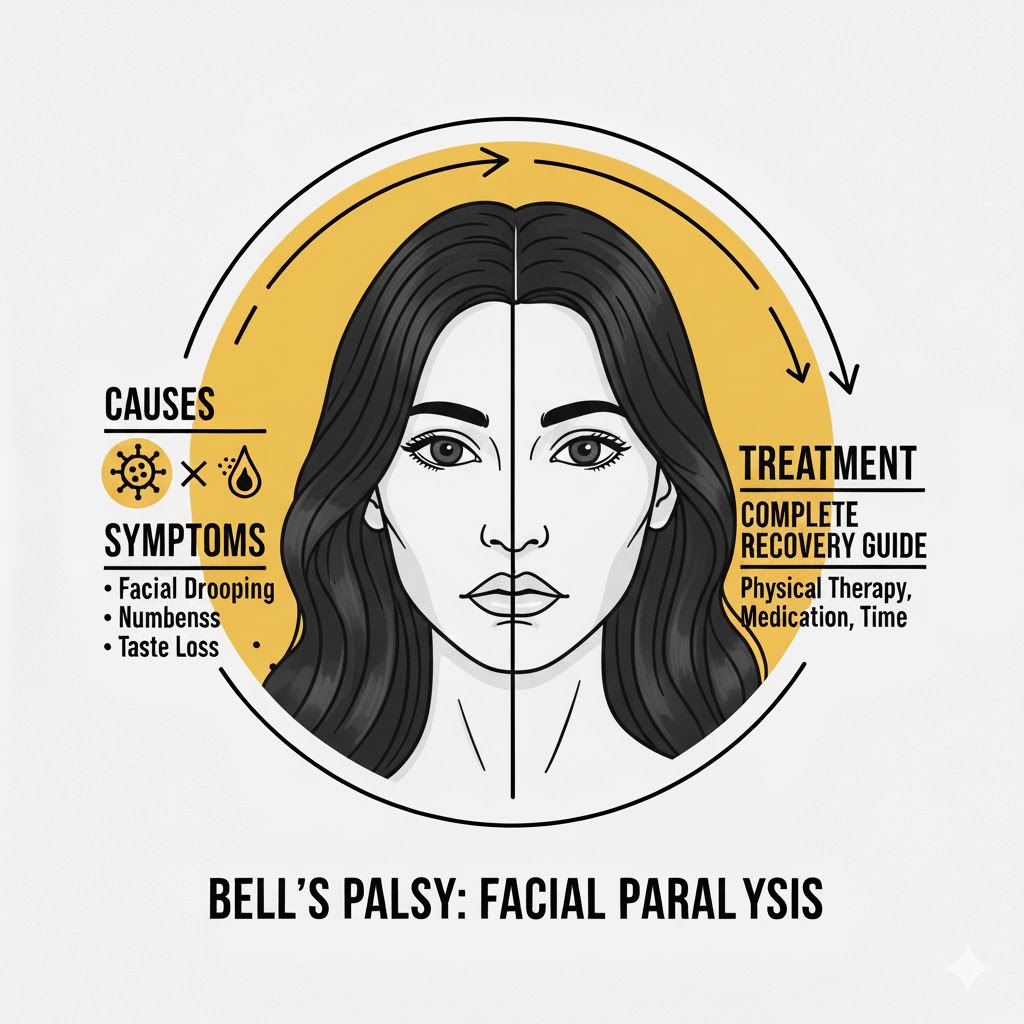The human face is more than just a reflection of our emotions — it’s how we express, connect, and communicate with the world. Every smile, frown, or blink plays a role in conveying who we are. But imagine waking up one morning, looking in the mirror, and realizing one side of your face isn’t moving. The smile feels uneven, your eye won’t close properly, and your reflection seems unfamiliar. This is often how Bell’s Palsy begins — suddenly, unexpectedly, and without warning.
Bell’s Palsy is a form of temporary facial paralysis caused by inflammation or damage to the facial nerve (cranial nerve VII). While it can be frightening at first, the good news is that in most cases, people recover fully with proper treatment and care. Understanding the condition — its causes, symptoms, and treatment options — can make a world of difference in managing recovery and preventing complications.
In this comprehensive guide, we’ll explore everything you need to know about Bell’s Palsy: what triggers it, how it affects the facial muscles, the best ways to diagnose and treat it, and most importantly, how to support a full and confident recovery. Whether you’re currently dealing with Bell’s Palsy or supporting someone who is, this guide aims to provide clarity, reassurance, and actionable steps toward healing.

Bell’s Palsy: Causes, Symptoms, and Treatment (Complete Recovery Guide for Facial Paralysis)
When you wake up one morning and realize that half of your face isn’t responding the way it should — your smile droops, your eye won’t close, and your reflection feels foreign — it can be terrifying. Many people’s first thought is a stroke. But for millions worldwide, this mysterious and sudden paralysis turns out to be Bell’s Palsy — a temporary condition that affects the facial nerve.
Although Bell’s Palsy can be distressing, the truth is that it’s treatable, temporary, and reversible in most cases. Understanding its causes, early symptoms, and the best ways to support your recovery can make all the difference.
This in-depth guide explains everything about Bell’s Palsy — what it is, why it happens, how it’s treated, and how you can heal both physically and emotionally.
Table of Contents
- What Is Bell’s Palsy?
- Understanding How the Facial Nerve Works
- Causes of Bell’s Palsy
- Risk Factors and Who Is Most at Risk
- Early Warning Signs and Symptoms
- How Bell’s Palsy Is Diagnosed
- Stages and Severity of Bell’s Palsy
- Medical Treatment Options
- Natural Remedies and Home Care
- Physical Therapy and Facial Exercises
- Eye Protection and Care Tips
- Diet and Nutrition for Nerve Recovery
- Emotional and Mental Health During Recovery
- How Long Does Bell’s Palsy Last?
- Possible Complications and Long-Term Effects
- Prevention Tips and Lifestyle Adjustments
- Living With Bell’s Palsy: Real-World Advice
- Frequently Asked Questions
- Final Thoughts
1. What Is Bell’s Palsy?
Bell’s Palsy is a type of temporary facial paralysis or weakness caused by damage or inflammation of the facial nerve (cranial nerve VII). This nerve controls most facial muscles — allowing you to smile, frown, blink, and move your lips.
When this nerve is compressed or inflamed, signals between your brain and facial muscles are disrupted, causing the affected side of your face to become weak or droopy.
Key Characteristics:
- It usually affects only one side of the face.
- It develops suddenly, often overnight.
- It’s usually temporary, with recovery in weeks or months.
- It is not related to a stroke, though the symptoms can appear similar.
2. Understanding How the Facial Nerve Works
To understand Bell’s Palsy, you first need to know the facial nerve’s function.
The facial nerve travels through a narrow bony canal in the skull. It branches out to control:
- Facial muscles (for expressions)
- Tear and saliva glands
- Taste from the front of the tongue
- Small muscles in the ear
Because it runs through such a tight space, even slight inflammation or swelling can compress the nerve, leading to weakness or paralysis.
3. Causes of Bell’s Palsy
The exact cause isn’t always clear, but viral infections are believed to be the primary trigger. The infection causes inflammation, swelling, or pressure around the nerve, disrupting its function.
Common Triggers and Causes:
- Herpes simplex virus (HSV-1): The same virus that causes cold sores.
- Varicella-zoster virus: Causes chickenpox and shingles.
- Epstein-Barr virus: Associated with mononucleosis.
- Cytomegalovirus and adenovirus: Can trigger inflammation.
- Influenza or respiratory infections: May contribute to nerve swelling.
- Lyme disease: Bacterial infection from tick bites can mimic Bell’s Palsy.
- Trauma or injury: Head or ear trauma can inflame the nerve.
- Reduced blood supply: Narrowed blood vessels may compress the nerve.
- Autoimmune reactions: The immune system attacks the nerve by mistake.
4. Risk Factors and Who Is Most at Risk
While anyone can get Bell’s Palsy, certain factors make some individuals more vulnerable:
- Pregnancy: Especially during the third trimester or after childbirth.
- Diabetes: Diabetic patients have a higher chance of nerve inflammation.
- High blood pressure: May reduce blood flow to facial nerves.
- Respiratory infections: Flu or colds can precede Bell’s Palsy episodes.
- Family history: Genetic predisposition increases risk.
- Stress and fatigue: Lower immunity can make nerves more sensitive.
- Cold exposure: Sudden chilling, such as sleeping near an AC vent.
5. Early Warning Signs and Symptoms
Bell’s Palsy typically develops within hours, reaching peak weakness in 48–72 hours.
Common Symptoms Include:
- Sudden drooping of one side of the face
- Inability to smile or close one eye
- Drooling from one side of the mouth
- Difficulty eating, drinking, or speaking
- Pain behind the ear or around the jaw
- Dryness or excessive tearing of the affected eye
- Heightened sensitivity to sound
- Loss of taste on one side of the tongue
- Twitching or minor facial spasms
Symptoms vary from mild weakness to complete paralysis.
6. How Bell’s Palsy Is Diagnosed
Diagnosis is mainly clinical, based on symptoms and physical examination.
Steps in Diagnosis:
- Medical history review – To check for infections or conditions.
- Physical exam – The doctor tests facial movements like smiling and eye closure.
- Electromyography (EMG) – Measures electrical activity in facial muscles.
- Imaging (MRI or CT scan) – To rule out stroke, tumors, or other nerve issues.
- Blood tests – To detect diabetes, infections, or Lyme disease.
Because Bell’s Palsy can resemble a stroke, immediate evaluation is vital.
7. Stages and Severity of Bell’s Palsy
Bell’s Palsy progresses through several phases:
Stage 1: Onset (0–48 hours)
Sudden facial drooping and weakness begin.
Stage 2: Peak Paralysis (2–7 days)
Full paralysis develops; facial asymmetry becomes noticeable.
Stage 3: Recovery (2–12 weeks)
Nerve function gradually improves, with small muscle twitches appearing.
Stage 4: Residual Weakness (3–6 months)
Minor stiffness, twitching, or tightness may persist.
Stage 5: Complete Recovery (6–12 months)
Most patients regain full facial function.
8. Medical Treatment Options
Early treatment dramatically improves recovery chances.
1. Corticosteroids
- Prednisone reduces nerve inflammation and swelling.
- Most effective when started within 72 hours of symptom onset.
2. Antiviral Drugs
- Acyclovir or valacyclovir may be prescribed if a viral infection is suspected.
- Combined with steroids for better results.
3. Pain Management
- Over-the-counter pain relievers like ibuprofen or acetaminophen can ease discomfort.
4. Eye Protection
Since eye closure may be difficult:
- Use artificial tears during the day.
- Apply lubricating ointment at night.
- Wear an eye patch while sleeping.
5. Physical Therapy
- Prevents facial muscles from tightening.
- Improves circulation and flexibility.
- Encourages nerve regeneration.
9. Natural Remedies and Home Care
Complementary approaches can accelerate recovery and relieve discomfort.
- Warm compresses: Apply gently to relax stiff muscles.
- Gentle facial massage: Stimulates blood flow and relieves tension.
- Essential oils: Lavender or rosemary oil (diluted) for soothing effect.
- Vitamin B complex: Supports nerve repair (B1, B6, and B12).
- Omega-3 fatty acids: Found in fish oil, promotes nerve healing.
- Acupuncture: May help stimulate muscle movement.
10. Physical Therapy and Facial Exercises
Consistent physical therapy enhances nerve and muscle recovery.
Effective Exercises:
- Eyebrow lifts: Raise eyebrows and hold for five seconds.
- Eye closure: Close eyes tightly, then relax.
- Smile training: Smile slowly and evenly.
- Cheek inflation: Puff out cheeks and hold air.
- Lip stretches: Move lips side-to-side and up-and-down.
- Mirror practice: Watch yourself perform exercises to ensure balance.
Repeat 5–10 times per session, several times a day.
11. Eye Protection and Care Tips
Dry eyes and irritation are common.
- Keep the eye moisturized with drops.
- Avoid dusty or windy environments.
- Use UV-protection sunglasses outdoors.
- Blink consciously to prevent dryness.
12. Diet and Nutrition for Nerve Recovery
Nutrition plays a key role in healing.
Foods to Include:
- Vitamin B12-rich foods: Fish, eggs, poultry.
- Antioxidants: Berries, spinach, broccoli.
- Omega-3s: Salmon, flaxseeds, walnuts.
- Magnesium: Almonds, avocados, whole grains.
- Protein: Lean meats and legumes for tissue repair.
Foods to Avoid:
- Processed foods and sugar (increase inflammation).
- Excess caffeine and alcohol.
- Very salty foods (can cause dehydration).
13. Emotional and Mental Health During Recovery
Bell’s Palsy can deeply affect self-image and mental well-being.
Some people experience social anxiety, embarrassment, or depression.
Coping Tips:
- Remind yourself recovery is temporary.
- Join Bell’s Palsy support groups.
- Share your experience with loved ones.
- Practice mindfulness and meditation.
- Focus on progress, not perfection.
14. How Long Does Bell’s Palsy Last?
Most people start to recover within 2–3 weeks, with complete recovery in 3–6 months.
Mild cases may heal faster, while severe ones may take longer.
15. Possible Complications and Long-Term Effects
While most recover completely, a few may experience:
- Synkinesis: Unintended facial movements during recovery.
- Residual weakness: Minor muscle tightness or twitching.
- Dry eye syndrome: From prolonged eye closure issues.
- Contractures: Rare cases of muscle shortening.
Regular therapy and follow-up can minimize these risks.
16. Prevention Tips and Lifestyle Adjustments
Bell’s Palsy can’t always be prevented, but healthy habits can reduce your risk.
Tips:
- Manage stress and get enough sleep.
- Keep your immune system strong with proper diet.
- Avoid sudden exposure to cold air.
- Treat ear infections promptly.
- Maintain blood sugar and blood pressure levels.
17. Living With Bell’s Palsy: Real-World Advice
Recovery can be emotionally challenging. Remember:
- You’re not alone — millions recover completely every year.
- Take pictures to track progress.
- Celebrate small improvements.
- Rest, stay hydrated, and be gentle with yourself.
Healing is not just about regaining movement — it’s about rebuilding confidence.
18. Frequently Asked Questions
Q1. Is Bell’s Palsy permanent?
Usually not. Most people recover within months.
Q2. Can Bell’s Palsy recur?
Yes, but recurrence is rare (about 7–10% of cases).
Q3. Can stress cause Bell’s Palsy?
Indirectly, yes. Stress weakens the immune system, making nerve inflammation more likely.
Q4. Is it contagious?
No. The underlying viral infections may be contagious, but Bell’s Palsy itself is not.
Q5. How can I smile again naturally?
Regular facial exercises, therapy, and time. The nerves slowly re-learn coordination.
19. Final Thoughts
Bell’s Palsy can change your appearance overnight — but with time, treatment, and self-care, your smile will return. The condition is temporary, treatable, and reversible for the vast majority of people.
The most important step is to seek medical care early, stay consistent with treatment, and stay positive through your recovery journey.
Your body is resilient. With patience, faith, and care, you can fully heal — and smile brighter than ever before.
